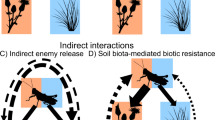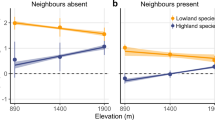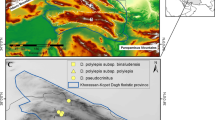Abstract
Many species are currently moving to higher latitudes and altitudes1,2,3. However, little is known about the factors that influence the future performance of range-expanding species in their new habitats. Here we show that range-expanding plant species from a riverine area were better defended against shoot and root enemies than were related native plant species growing in the same area. We grew fifteen plant species with and without non-coevolved polyphagous locusts and cosmopolitan, polyphagous aphids. Contrary to our expectations, the locusts performed more poorly on the range-expanding plant species than on the congeneric native plant species, whereas the aphids showed no difference. The shoot herbivores reduced the biomass of the native plants more than they did that of the congeneric range expanders. Also, the range-expanding plants developed fewer pathogenic effects4,5 in their root-zone soil than did the related native species. Current predictions forecast biodiversity loss due to limitations in the ability of species to adjust to climate warming conditions in their range6,7,8. Our results strongly suggest that the plants that shift ranges towards higher latitudes and altitudes may include potential invaders, as the successful range expanders may experience less control by above-ground or below-ground enemies than the natives.
This is a preview of subscription content, access via your institution
Access options
Subscribe to this journal
Receive 51 print issues and online access
$199.00 per year
only $3.90 per issue
Buy this article
- Purchase on Springer Link
- Instant access to full article PDF
Prices may be subject to local taxes which are calculated during checkout



Similar content being viewed by others
References
Walther, G. R. et al. Ecological responses to recent climate change. Nature 416, 389–395 (2002)
Parmesan, C. & Yohe, G. A globally coherent fingerprint of climate change impacts across natural systems. Nature 421, 37–42 (2003)
Pearson, R. G. & Dawson, T. P. Predicting the impacts of climate change on the distribution of species: are bioclimate envelope models useful? Glob. Ecol. Biogeogr. 12, 361–371 (2003)
Klironomos, J. N. Feedback with soil biota contributes to plant rarity and invasiveness in communities. Nature 417, 67–70 (2002)
Van Grunsven, R. H. A. et al. Reduced plant-soil feedback of plant species expanding their range as compared to natives. J. Ecol. 95, 1050–1057 (2007)
Warren, M. S. et al. Rapid responses of British butterflies to opposing forces of climate and habitat change. Nature 414, 65–69 (2001)
Thomas, C. D. et al. Extinction risk from climate change. Nature 427, 145–148 (2004)
Thomas, J. A. et al. Comparative losses of British butterflies, birds, and plants and the global extinction crisis. Science 303, 1879–1881 (2004)
Lovejoy, T. E. & Hannah, L. Climate Change and Biodiversity. (Yale Univ. Press, 2005)
Brinkhuis, H. et al. Episodic fresh surface waters in the Eocene Arctic Ocean. Nature 441, 606–609 (2006)
Tamis, W. L. M. et al. Changes in vascular plant biodiversity in the Netherlands in the 20th century explained by their climatic and other environmental characteristics. Clim. Change 72, 37–56 (2005)
Levine, J. M. et al. Plant-soil feedbacks and invasive spread. Ecol. Lett. 9, 1005–1014 (2006)
Keane, R. M. & Crawley, M. J. Exotic plant invasions and the enemy release hypothesis. Trends Ecol. Evol. 17, 164–170 (2002)
Menendez, R. et al. Escape from natural enemies during climate-driven range expansion: a case study. Ecol. Entomol. 33, 413–421 (2008)
van der Putten, W. H. et al. Linking above- and belowground multitrophic interactions of plants, herbivores, pathogens, and their antagonists. Trends Ecol. Evol. 16, 547–554 (2001)
Maron, J. L. & Vila, M. When do herbivores affect plant invasion? Evidence for the natural enemies and biotic resistance hypotheses. Oikos 95, 361–373 (2001)
Callaway, R. M. et al. Soil biota and exotic plant invasion. Nature 427, 731–733 (2004)
Reinhart, K. O. et al. Plant-soil biota interactions and spatial distribution of black cherry in its native and invasive ranges. Ecol. Lett. 6, 1046–1050 (2003)
Mitchell, C. E. & Power, A. G. Release of invasive plants from fungal and viral pathogens. Nature 421, 625–627 (2003)
van der Putten, W. H. et al. Invasive plants and their escape from root herbivory: a worldwide comparison of the root-feeding nematode communities of the dune grass Ammophila arenaria in natural and introduced ranges. Biol. Invasions 7, 733–746 (2005)
Agrawal, A. A. et al. Enemy release? An experiment with congeneric plant pairs and diverse above- and belowground enemies. Ecology 86, 2979–2989 (2005)
Bever, J. D., Westover, K. M. & Antonovics, J. Incorporating the soil community into plant population dynamics: the utility of the feedback approach. J. Ecol. 85, 561–573 (1997)
Parker, J. D., Burkepile, D. E. & Hay, M. E. Opposing effects of native and exotic herbivores on plant invasions. Science 311, 1459–1461 (2006)
Funk, J. L. & Vitousek, P. M. Resource-use efficiency and plant invasion in low-resource systems. Nature 446, 1079–1081 (2007)
Davis, A. J. et al. Making mistakes when predicting shifts in species range in response to global warming. Nature 391, 783–786 (1998)
Both, C. & Visser, M. E. Adjustment to climate change is constrained by arrival date in a long-distance migrant bird. Nature 411, 296–298 (2001)
Guisan, A. & Thuiller, W. Predicting species distribution: offering more than simple habitat models. Ecol. Lett. 8, 993–1009 (2005)
van der Putten, W. H. et al. Soil feedback of exotic savanna grass relates to pathogen absence and mycorrhizal selectivity. Ecology 88, 978–988 (2007)
Acknowledgements
We thank Staatsbosbeheer Regio Oost for giving us permission to work in Millingerwaard; B. Odé, K. Groen, R. van Grunsven, P. Brinkman and the late R. van der Meijden for discussions; M. Houtekamer for carbon and nitrogen determination; T. Vos, M. Vlag, A. Weerheijm and W. Smant for assistance; L. Koopman for providing the locusts; and L. Young and E. J. Bakker for advice on statistics. This study was funded by an ALW-VICI grant to W.H.v.d.P.
Author Contributions T.E., E.M., T.M.B., J.A.H. and W.H.v.d.P. designed and analysed the experiment and wrote the manuscript; T.E. and E.M. performed the experiment; W.L.M.T. analysed the long-term floristic dataset and provided the data for selecting plant species; and K.J.F.V., L.M.McI. and A.B. carried out the data analysis and were involved in the writing.
Author information
Authors and Affiliations
Corresponding author
Supplementary information
Supplementary Information
This file contains Supplementary Notes, Supplementary Table 1 and Supplementary Figures 1-5 with Legends. (PDF 1750 kb)
Rights and permissions
About this article
Cite this article
Engelkes, T., Morriën, E., Verhoeven, K. et al. Successful range-expanding plants experience less above-ground and below-ground enemy impact. Nature 456, 946–948 (2008). https://doi.org/10.1038/nature07474
Received:
Accepted:
Published:
Issue Date:
DOI: https://doi.org/10.1038/nature07474
This article is cited by
-
Giant African snail invasion homogenizes seasonal soil biodiversity in tropical coral islands
Plant and Soil (2024)
-
Negative plant-soil feedbacks disproportionally affect dominant plants, facilitating coexistence in plant communities
npj Biodiversity (2023)
-
Development of negative soil feedback by an invasive plant near the northern limit of its invaded range
Plant Ecology (2023)
-
Plant–soil interactions in the native range of two congeneric species with contrasting invasive success
Oecologia (2023)
-
Pathogen resistance in Sphagneticola trilobata (Singapore daisy): molecular associations and differentially expressed genes in response to disease from a widespread fungus
Genetica (2022)
Comments
By submitting a comment you agree to abide by our Terms and Community Guidelines. If you find something abusive or that does not comply with our terms or guidelines please flag it as inappropriate.



